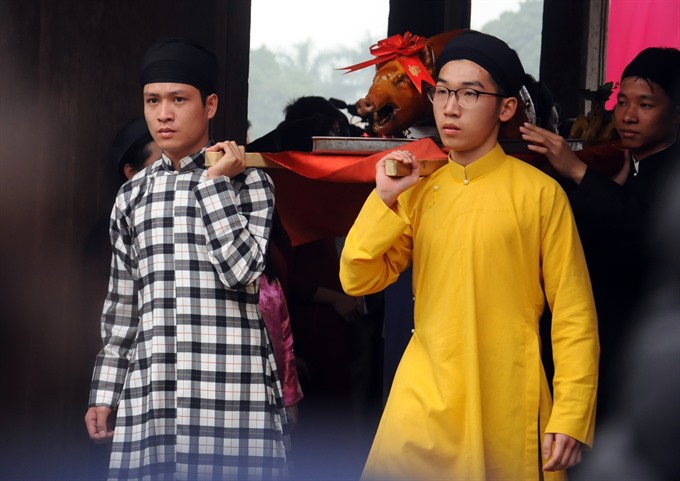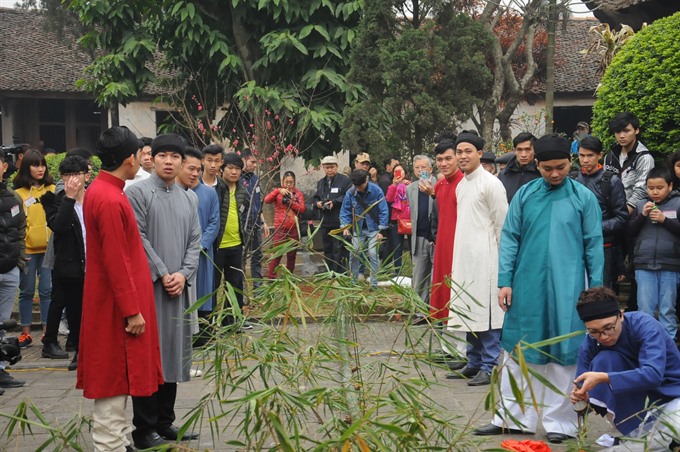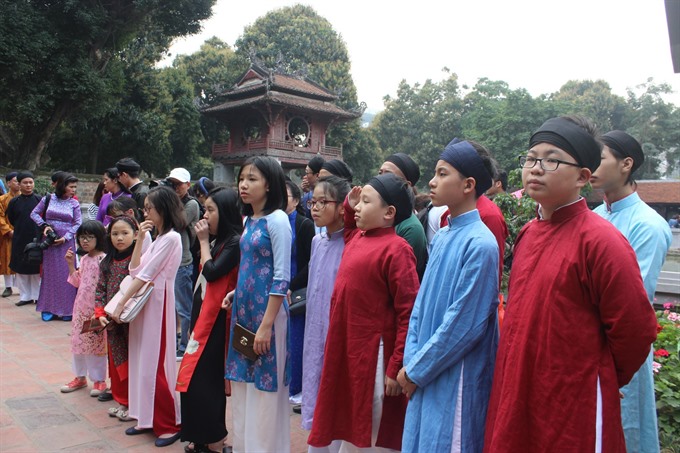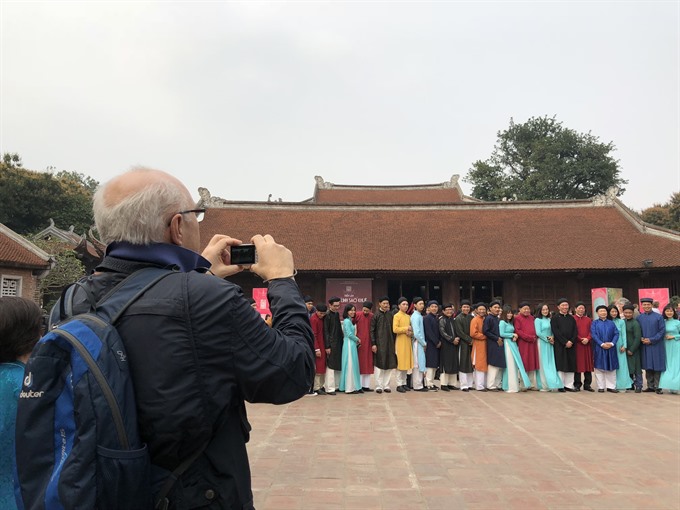 |
| Join the club: Men are encouraged to wear ao dai at events hosted by Dinh Lang Viet Group. VNS Photo Nguyen Le Hoang |
Viet Nam News
Traditional long dress for men are being revived thanks to the enthusiasm of a club in Ha Noi. Unlike women’s traditional long dress, the men’s version has experienced various ups and downs. Le Huong & Hong Van explore.
Carefully wrapping a black turban on his friend’s head, Chu Duc Giang is helping his friend take a trip back in time.
With the sun shining as bright as the clothes Giang and his friend wear, these two young men are keeping a tradition alive through the robes on their backs.
They spent a Sunday morning joining other members of the Traditional Long Dress for Men’s Club to tour the Literature Temple and the Imperial Academy,, the first university of Viet Nam built in 11th century in downtown Ha Noi.
The men’s group wear ao dai (traditional long dress) and during their tour, pause from time to time to lend a listening ear to the guide.
Although they may look like they have arrived from days gone by, their ancient appearance is given a modern twist as many reach for their cell phones to take a selfie or two.
The newly established club, a smaller group of Dinh Lang Viet (Vietnamese Communal Houses), which is keen on preserving the ancient values of communal houses, sometimes organises such an event to encourage members to wear ao dai.
As well as drawing many a curious glance from foreign tourists, they hope their clothing with see other men follow suit.
“As a member of Dinh Lang Viet group, I joined most of its activities including Tet Viet (Vietnamese traditional Lunar New Year) event at So Village on the outskirts of Ha Noi. At the first event three years ago, I rented an ao dai. Then I got one tailored. Recently, another club member Hoang Duong and I designed a collection of ao dai titled ‘Now and Then’ of items with traditional features adequately changed to suit modern times,” Giang told Viet Nam News.
As a young man who loves traditional culture, Giang feels proud whenever he wears ao dai.
“I think ao dai is not only beautiful in aesthetic but also in moral standards. When wearing it, I feel more mature and tend to be more careful in my behaviour. The costume makes me Mr Right in the traditional standard. It is a heritage from our ancestors,” he said.
Giang added that some details from the traditional design were changed to suit today’s youth such as smaller sleeves, smaller hems for pants and various modern materials such as linen, tweed and even jeans.
 |
| New year: Members of the group wear ao dai at Tet Viet (Traditional Lunar New Year) event at So Communal House on February 10. VNS Photo Nguyen Le Hoang |
According to Nguyen Duc Binh, chairman of the club, there are too many changes in modern ao dai that make it alien and increasingly like traditional costumes of other countries.
“Our club promotes traditional dress in original design with five flaps. We want all those who like to wear and possess the traditional dress can join our activities. So, the number of members is flexible and can mount up to dozens mostly around Ha Noi,” he said.
Appearing in most of the Dinh Lang Viet’s events, Assistant to Minister for Foreign Affairs Pham Sanh Chau could not hide his pride in ao dai.
“I normally wear ao dai in diplomatic events outside the country,” he said.
“I feel that it makes me quite different from others and it helps to single me out as a representative of Viet Nam. At our diplomatic activities, we are sometimes obliged to wear traditional dress as a requirement to be able to attend a big gathering.”
He recalled the time he was in Belgium, whenever he had an opportunity to meet the King, he wore ao dai. And the following day, he became front page news.
“Because people like to take pictures of those who are quite different from others. I feel that this is also a way to promote Viet Nam and stress the identity of the Vietnamese people,” he added.
Up and down history
According to researcher Nguyen Xuan Hoa, long dress for men appeared in the early reigns of the Ly (1009-1225), Tran (1226-1400) and Le (1428-1527) dynasties, and that was called Giao Linh style.
The ao dai as we see today originated from the era of Lord Nguyen Phuc Khoat (1714-1765).
In 1744, when he came to the throne in Phu Xuan, he issued a decree to define costumes of men and women of all walks of life for Dang Trong (central and southern of today’s Viet Nam) area.
“The Nguyen Dynasty had restricted regulations in ao dai costumes for royal members and ordinary people,” said researcher Doan Thi Tinh specialising in Vietnamese costumes.
The long dress for men had a basic design with a straight neck and five flaps of five cloth pieces running along the body: two in front, two in the back and one shorter layer under the two front flaps.
The two layers join each other by a row of five buttons running from the neck to under the arms.
The typical layout was the result of a small loom of cloth weavers at that time. The width of each cloth was not more than 40cm.
Depending on the social status or the situation of the wearer, the five-flap long dress would have small differences in materials, styles or colours.
“That’s why ao dai is a silent introduction of the wearer,” she said.
“Looking at it, one would have certain judgements about the wearers. In the feudal time, people had a rule that when receiving guests at home, the owners would wear ao dai. They always wear double ao dai. The inner must be white, silk for the rich and cotton for the poor.”
 |
| Next generation: Teenagers, children of the club members, wearing ao dai at an event at the Literature Temple. VNS Photo Le Huong |
 |
| Vietnamese pride: A foreign tourist takes photos of members of the Traditional Long Dress for Men Club at the Literature Temple. VNS Photo Le Huong |
The white symbolises cleanliness and also serves as a good background for the colour of the outer coat, Tinh added.
In worship ceremonies, the host wore ao dai in red (the colour of the sun that receives the powers of the universe) while aides at the ceremony would wear blue.
Though it had served as a popular costume for men of various classes, long dress for men has a different fate than long dress for women, which has always been considered as the national costume.
Over time, with the widespread of western costumes that came with the French, long dress for men was replaced by office suit.
Hoa analysed that men’s long dress has experienced three periods of degradation. The first was in the 1930s when Viet Nam was widely opened to the western culture.
The next was when the Nguyen reign, or more exactly the monarchy, ended in 1945, and particularly during the Indochina wars people considered long dress for both men and women as a vestige of feudalism, he said.
In the next decades, though the dress was judged again for its true value, it was still less popular among young people due to limited conditions of living and working, he continued.
“Ao dai for men became less and less popular over time but it still existed in traditional culture,” commented Tinh.
For example, during the war against the French between 1945 and 1954, men could not wear ao dai in battles but the old people in Ha Noi at that time still wore it.
Men working for the French wore suits at work but they still wore traditional long dress at weddings or during the Lunar New Year. Men in rural areas kept their long dress and turban as valuable costumes, she said.
“At our club, young men, who were born after the country’s renewal process in 1986, are even more enthusiastic about traditional long dress than older men as they are not affected by the thought that the attire for men is a vestige of feudalism,” Binh said.
“We hope to revive the costume,” he said. — VNS
OVietnam